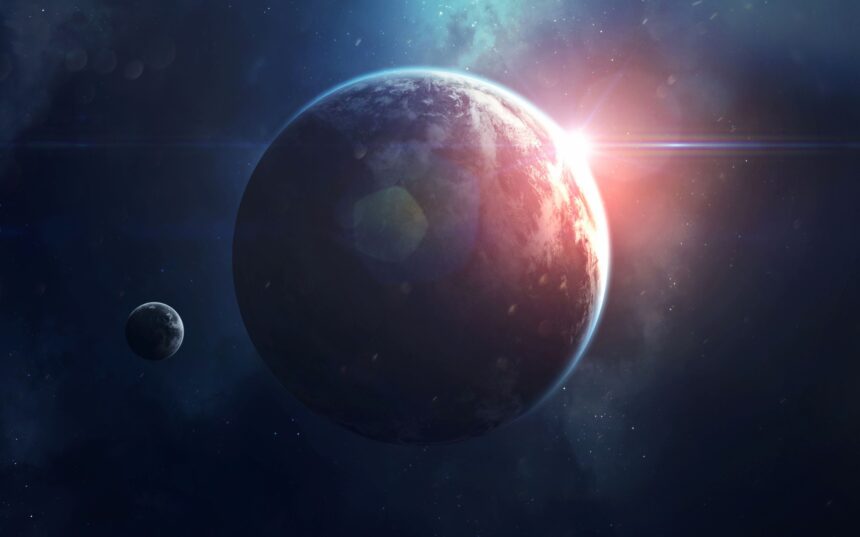Astronomers are abuzz with excitement after spotting indirect hints of a elusive “Planet Y” tucked away in the far reaches of our solar system. This ghostly world, possibly influencing the erratic paths of icy remnants near the Kuiper Belt, might bridge a gap in our understanding of cosmic architecture. As speculation swirls about links to the legendary Nibiru, could this be the breakthrough that expands our stellar neighborhood?
Unmasking Planet Y: Size, Path, and the Thrill of the Unknown
Picture a rogue planet that’s no lightweight but far from a heavyweight—envision something heftier than Mercury yet lighter than our own blue marble, Earth. That’s the intriguing blueprint for Planet Y, a proposed wanderer circling the Sun at a mind-boggling 100 to 200 times the Earth-Sun span. What sets it apart? An orbital slant of over 10 degrees, defying the mostly level alignment of the planets we know and love.
This isn’t a direct sighting—telescopes haven’t caught its glow yet. Instead, it’s a detective story pieced from gravitational whispers. Researchers sifted through orbital data from nearly 50 remote Kuiper Belt objects and uncovered a baffling 15-degree warp, peaking at roughly 80 times the Earth-Sun distance. Traditional theories on planetary birth, rogue stellar flybys, or even the rumored Planet Nine fell short in explaining it. Enter Planet Y: simulations reveal it as the subtle shepherd herding these frozen outliers into their off-kilter routes.
The Spark Behind the Solar System’s Tilted Surprise
The Kuiper Belt, that expansive halo of frozen chunks past Neptune—think Pluto’s stomping grounds—has long been a treasure trove of oddities. But this latest anomaly? It’s a game-changer. Lead investigator Amir Siraj, a PhD student at Princeton, shared his astonishment: “It was quite a surprise to find that the solar system suddenly appears to be tilted by about 15 degrees, and this is what sparked the Planet Y hypothesis.”
Published in the prestigious Monthly Notices of the Royal Astronomical Society: Letters, the research doesn’t claim a full reveal. As Siraj clarifies, “One explanation is the presence of an unseen planet, probably smaller than the Earth and probably bigger than Mercury, orbiting in the deep outer solar system. This paper is not a discovery of a planet, but it’s certainly the discovery of a puzzle for which a planet is a likely solution.” It’s a tantalizing clue, not a smoking gun, urging us to rethink the solar system’s hidden layers.
Planet Y vs. Planet Nine: Room for Two Cosmic Giants?
Don’t confuse this with Planet Nine, the beefier hypothetical beast—packing 5 to 10 Earth masses and prowling even deeper into the void. Planet Y is more compact and nearer, yet the duo could coexist, with Nine’s shadow inspiring deeper dives into the Kuiper’s quirks. Together, they paint a picture of a solar system that’s dynamically diverse, far from the tidy textbook model.
Nibiru Whispers: Ancient Lore Meets Modern Mystery?
The Nibiru angle? It’s the stuff of ancient tales and end-times chatter, a supposed interloper from Sumerian skies. While the study stays firmly in science’s lane, the notion of a veiled planet on the fringes inevitably stirs the pot. Is Planet Y the rational reboot of that myth? Science says hold off on the hype—it’s evidence-based, not apocalyptic. Still, it fuels the imagination, blending fact with folklore in the quest for what’s out there.
The Hunt Heats Up: Rubin Observatory’s Role in Spotting the Unseen
Excitement builds for validation, and it might not take eons. The Vera C. Rubin Observatory in Chile launches its epic 10-year cosmic scan this year, armed to potentially unmask Planet Y—or its bigger sibling—in as little as two to three years. Spotting it could shatter paradigms on how worlds form and migrate, revealing a more turbulent solar past.
As we peer deeper, Planet Y reminds us: the universe loves a good plot twist. What secrets does it hold? Share your cosmic theories in the comments—could this rewrite the stars? For the freshest on space enigmas, dive into “Kuiper Belt secrets” or “hypothetical planets explained.”
















